The Philippines has a rich history shaped by colonial influences, particularly during the American era. This period marked a significant shift in the nation’s identity and collective sentiment. The transition from Spanish to American rule brought new challenges and opportunities for the Filipino people.
During this time, the concept of a unified nation began to take root. Leaders and thinkers emerged, advocating for self-governance and cultural pride. The struggle for independence became a defining moment in the country’s history.
American rule introduced modern systems of governance and education. These changes played a crucial role in shaping the Filipino identity. The desire for autonomy grew stronger, leading to movements that sought to reclaim the nation’s sovereignty.
This article explores how American colonial influence fueled the rise of Filipino nationalism. It examines the historical events and key figures that shaped this era. By understanding this period, we gain insight into the Philippines’ journey toward independence.
Key Takeaways
- American rule significantly influenced the development of Filipino identity.
- The struggle for independence became a central focus during this period.
- Modern governance and education systems were introduced under American rule.
- Leaders and thinkers played a vital role in advocating for self-governance.
- The desire for autonomy grew stronger, leading to nationalist movements.
Introduction to Filipino Nationalism Under American Rule
The American colonial period in the Philippines was a transformative era that reshaped the nation’s identity. The shift from Spanish to American rule brought significant changes in governance, education, and culture. These changes laid the foundation for a growing sense of unity among Filipinos.
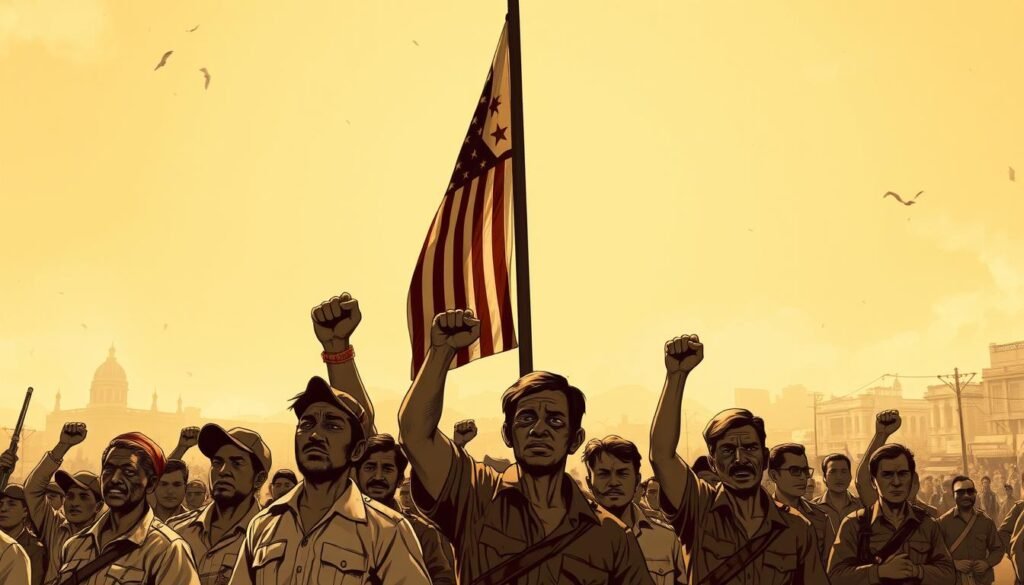
Historical Overview of Colonial Influence
American rule introduced modern systems that influenced the Philippines’ development. The establishment of public schools and the spread of English created a new cultural landscape. These changes helped Filipinos connect with the broader world while preserving their local traditions.
Key policies, such as the Jones Law of 1916, promised eventual independence. This encouraged Filipinos to strive for self-governance. Leaders like Manuel L. Quezon and Sergio Osmeña emerged, advocating for autonomy and national pride.
Significance of the Nationalist Movement
The nationalist movement during this period was crucial in shaping the Philippines’ future. It fostered a collective identity and a desire for sovereignty. As one historian noted,
“The struggle for independence became a defining moment in the nation’s history.”
Educational reforms played a vital role in this awakening. By the 1930s, literacy rates had doubled, and English became widely spoken. This empowered Filipinos to engage in political discourse and demand their rights.
| Key Policies | Impact |
|---|---|
| Jones Law (1916) | Promised independence, encouraging self-governance |
| Public Education | Increased literacy and cultural awareness |
| English Language | Connected Filipinos to the global community |
This period was not just about political change. It was a time when Filipinos began to see themselves as a unified person with a shared destiny. The legacy of this era continues to influence the Philippines today.
Understanding Nationalism in the Filipino Context
The concept of a unified Filipino state began to take shape under American influence. This period marked a shift toward defining what it meant to be Filipino, blending cultural identity with political aspirations. Nationalism, in this context, became a driving force for unity and self-governance.
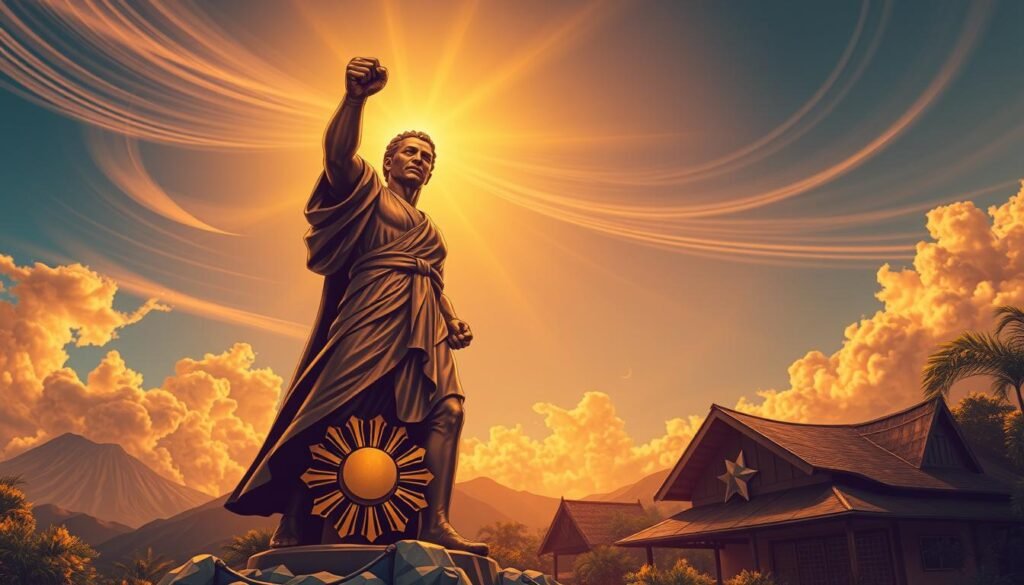
Defining Nationalism and Its Core Elements
Nationalism in the Philippines is rooted in the desire for state sovereignty and cultural pride. It emphasizes the right to self-determination, a principle that gained momentum during the American colonial era. Leaders like Claro Mayo Recto championed this cause, advocating for an independent foreign policy.
Core elements of Filipino nationalism include collective mobilization and the preservation of local traditions. These ideals were shaped by historical struggles against colonial powers. As Recto noted,
“Nationalism is a growing and deepening consciousness of being a distinct people.”
Classical nationalism focused on independence and cultural identity. Modern interpretations, influenced by educational reforms, expanded to include global perspectives. This evolution reflects the dynamic nature of Filipino thought.
The right to self-determination evolved under external influences, such as American governance. This shift empowered Filipinos to demand autonomy and shape their political future. The intersection of local and international ideologies further enriched the nationalist movement.
Historical Roots of Filipino National Identity
Long before colonial powers arrived, the Philippines had a vibrant culture rooted in indigenous traditions. These early influences laid the groundwork for the country‘s unique identity. From societal organization to artistic expression, pre-colonial Philippines was a thriving society with its own distinct systems.
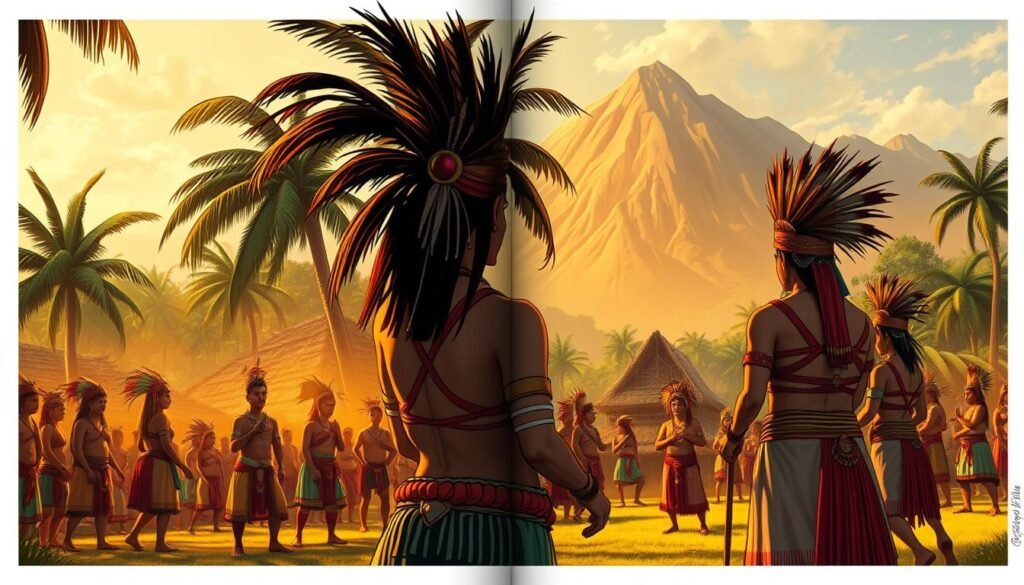
Pre-colonial Influences and Indigenous Traditions
Pre-colonial Philippines was organized into barangays, small communities led by chieftains. These societies were self-sufficient and governed by local laws. Trade flourished, connecting islands and fostering cultural exchange. This early form of governance set the stage for later political developments.
Art and literature also played a significant role in shaping identity. Indigenous epics like the Hudhud and Biag ni Lam-ang reflected the values and beliefs of early Filipinos. These works, passed down orally, preserved the history and traditions of the people.
Religious practices were deeply tied to nature and ancestral worship. Rituals and ceremonies honored spirits and deities, fostering a sense of community. These traditions continue to influence Filipino culture today.
The transformation from indigenous cultural forms to a unified national identity was gradual. Colonial influences introduced new systems, but the foundation remained rooted in pre-colonial heritage. This blend of old and new shaped the Philippines into the country it is today.
American Political and Cultural Imprints
American colonial rule left a lasting mark on the Philippines, shaping its political and cultural landscape. Key policies introduced during this period sparked debates and raised important questions about identity and governance. The year 1916, for instance, marked a turning point with the Jones Law, which promised eventual independence.
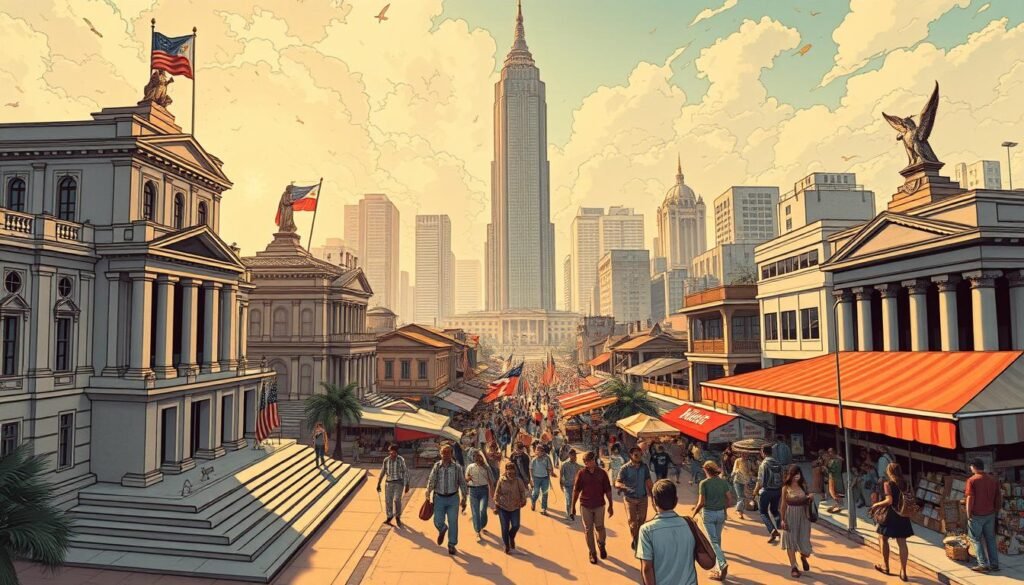
One major conflict arose from the tension between American ideals and Filipino traditions. Educational reforms, while increasing literacy, also created cultural divides. Filipinos began to question their role in a colonial system that imposed foreign values.
Political strategies like the establishment of public schools and the spread of English had dual effects. They connected Filipinos to the global community but also challenged local customs. This conflict of identities fueled a desire for self-governance.
By the year 1935, the Philippines had its first constitution, a milestone in its journey toward independence. However, the process was not without conflict. Debates over colonial duty and national pride highlighted the complexities of this transition.
These imprints, both political and cultural, contributed to a sharper national consciousness. The questions raised during this period continue to resonate in the Philippines today, shaping its ongoing quest for sovereignty.
Emergence of a National Consciousness
The rise of a unified Filipino identity was deeply influenced by ideological shifts during American rule. These changes, combined with the mobilization of key institutions, fostered a growing sense of national consciousness. The transition from colonial governance to self-awareness was marked by significant events and debates.
One of the most critical factors was the role of war and conflict. The Philippine-American War (1899-1902) intensified feelings of unity and resistance. This period highlighted the need for collective action against foreign domination, solidifying the idea of a distinct Filipino identity.
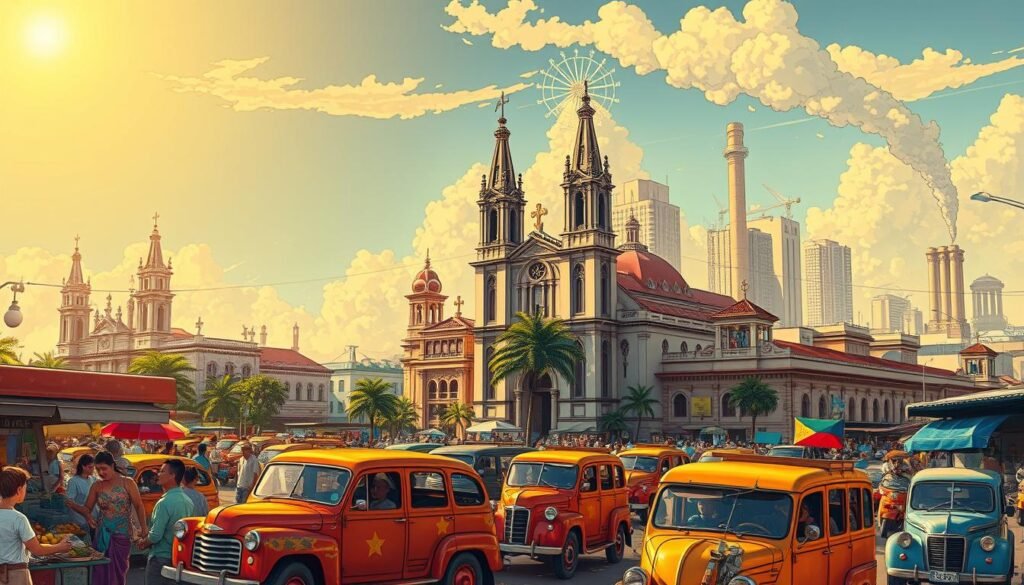
Educational and religious institutions played a vital role in shaping this consciousness. Public schools introduced by the Americans became platforms for spreading new ideas. Religious organizations, on the other hand, preserved local traditions while advocating for social reforms.
Key ideological debates also emerged during this time. Leaders like Claro Mayo Recto emphasized the importance of self-determination. As Recto noted,
“The Filipino people must define their own destiny, free from external influences.”
These debates spurred self-awareness and encouraged Filipinos to demand autonomy.
The emergence of this national consciousness paved the way for future political movements. By the 1930s, the Philippines was on a clear path toward independence. This period remains a cornerstone in the nation’s history, shaping its identity and aspirations.
| Key Factors | Impact |
|---|---|
| War and Conflict | Intensified national unity and resistance |
| Educational Institutions | Spread new ideas and fostered cultural awareness |
| Religious Organizations | Preserved traditions while advocating for reforms |
| Ideological Debates | Spurred self-awareness and demands for autonomy |
For more insights into this transformative period, explore Simon Ola and the Fight for Filipino. This resource provides a deeper understanding of the struggles and triumphs that defined this era.
Role of Education and Media in Shaping Identity
Education and media became powerful tools in shaping Filipino identity during the American colonial period. These platforms not only introduced modern systems but also fostered a sense of cultural pride and unity. Through reforms and campaigns, Filipinos began to reclaim their heritage while embracing new ideas.
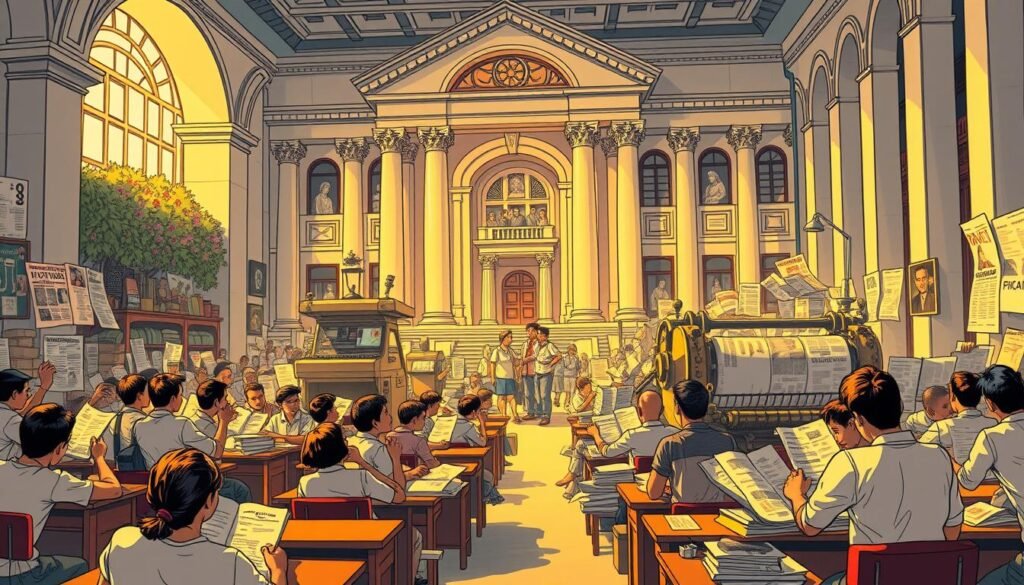
Promotion of Vernacular Languages and Literature
The promotion of local languages and literature was a significant step in cultural awakening. Unlike other colonial powers, the Americans encouraged the use of vernacular languages alongside English. This approach allowed Filipinos to preserve their linguistic heritage while adapting to global communication.
Literary movements flourished during this time, blending traditional forms with modern influences. For example, writers like Jose Garcia Villa and Amado Hernandez used their works to express national pride and resistance. Their writings became a platform for advocating independence and cultural identity.
Modernization and Cultural Rebirth
Modernization efforts in education and media sparked a cultural rebirth in the Philippines. Public schools introduced by the Americans became centers for intellectual growth and national consciousness. Media, on the other hand, served as a bridge between traditional values and modern aspirations.
Comparisons can be drawn with Germany, where educational reforms also played a crucial role in shaping national identity. In both cases, the integration of local and global influences created a unique cultural landscape. As one scholar noted,
“The fusion of tradition and modernity is essential for cultural evolution.”
This period marked a turning point in Filipino history, laying the foundation for a unified and resilient identity.
Comparative Perspectives: Filipino and European Nationalisms
The evolution of Filipino identity shares striking parallels with European movements, yet diverges in key ways. Both regions sought to define their identity through collective mobilization and cultural pride. However, the paths they took reflect their unique historical and political contexts.
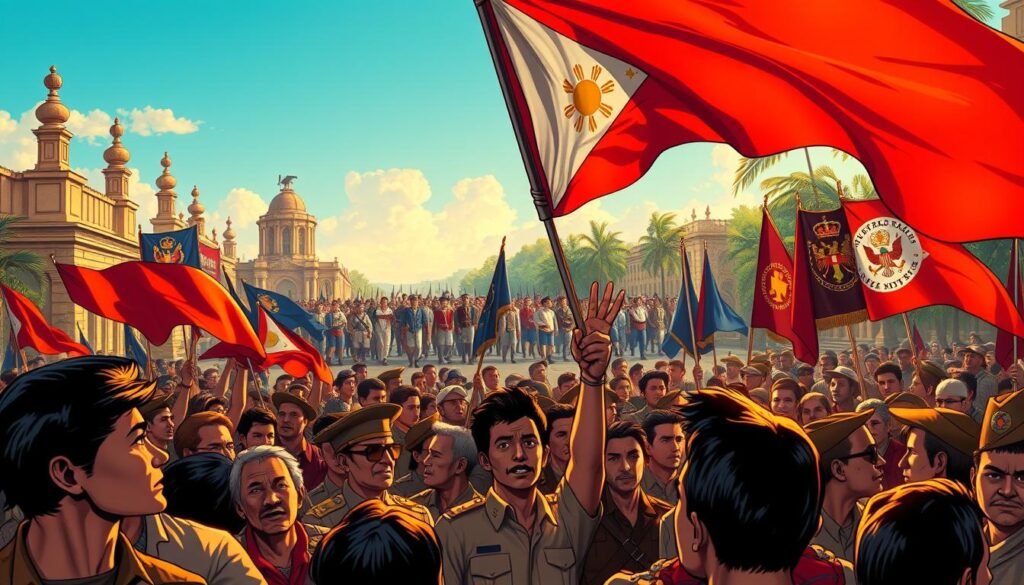
Similarities in Ideological Claims
Filipino and European nationalisms both emphasized the claim to self-determination. In Europe, movements like those in Italy and Germany focused on unifying fragmented states. Similarly, Filipino leaders advocated for autonomy under colonial rule. Both regions used education and media to foster a shared sense of purpose.
Another similarity lies in the role of external influences. European nationalism was shaped by Enlightenment ideas, while Filipino identity evolved under American governance. These external forces, though different, played a crucial role in shaping each movement’s goals.
Diverging Paths in Political and Cultural Outcomes
While both movements sought independence, their outcomes differed significantly. European nationalism often led to the creation of unified nation-states. In contrast, Filipino nationalism culminated in a struggle against colonial powers, delaying full sovereignty.
Culturally, European movements often emphasized ethnic homogeneity. Filipino nationalism, on the other hand, embraced diversity, blending indigenous traditions with colonial influences. This multifaceted approach reflects the Philippines’ unique historical journey.
External pressures also shaped these diverging paths. European nationalism was often driven by internal conflicts, while Filipino identity was forged in resistance to foreign domination. These differences highlight the complexity of identity formation in varying political contexts.
Ultimately, the comparison between Filipino and European nationalisms reveals both shared aspirations and distinct outcomes. Understanding these parallels and divergences offers valuable insights into the global nature of identity and self-determination.
The Evolution of Nationalism Through Centuries
The journey of Filipino identity has been shaped by centuries of political and cultural transformations. From pre-colonial traditions to modern governance, the Philippines has witnessed pivotal moments that defined its national consciousness. These milestones reflect a blend of local heritage and global influences, creating a unique path toward unity and self-determination.
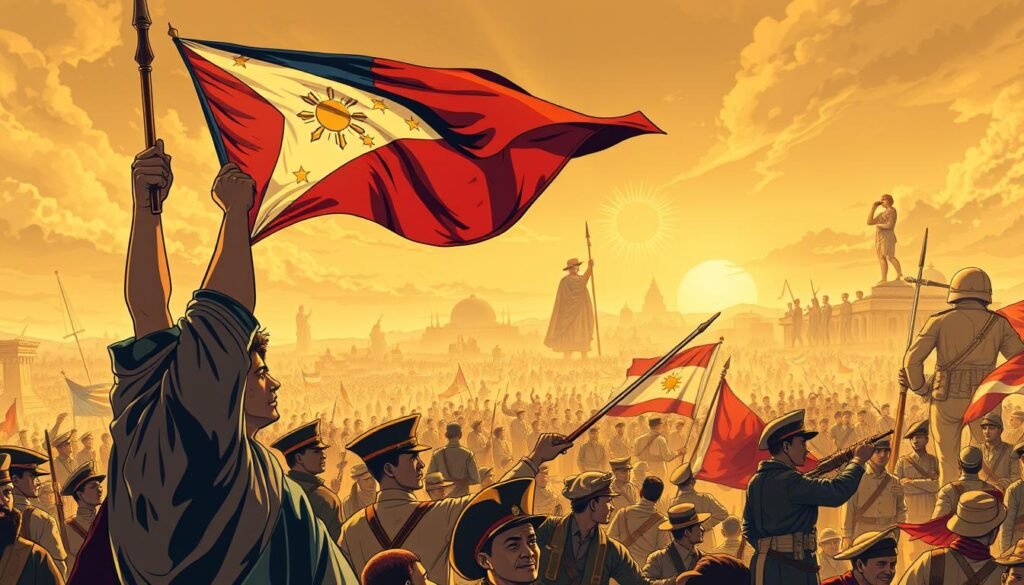
Key Milestones in the Nationalist Movement
The development of Filipino identity can be traced through significant historical events. The government reforms introduced during the American colonial era played a crucial role. These changes, combined with cultural shifts, laid the foundation for a unified national identity.
One of the earliest milestones was the establishment of the Katipunan in 1892. This secret society aimed to unite Filipinos against Spanish rule. Its influence sparked the Philippine Revolution, a turning point in the nation’s history. As one historian noted,
“The Katipunan symbolized the first collective effort to reclaim Filipino sovereignty.”
Another key moment was the Jones Law of 1916, which promised eventual independence. This policy encouraged Filipinos to strive for self-governance. Leaders like Manuel L. Quezon emerged, advocating for autonomy and national pride.
The influence of Europe also played a role in shaping Filipino identity. The French Revolution’s ideals of liberty and equality resonated with Filipino leaders. These ideas inspired movements that sought to define the nation’s future.
| Milestone | Impact |
|---|---|
| Katipunan (1892) | United Filipinos against Spanish rule |
| Jones Law (1916) | Promised independence, encouraging self-governance |
| Cultural Renaissance (1930s) | Revived local traditions and arts |
These milestones contributed to the consolidation of Filipino identity. They reflect the interplay between government reforms and cultural shifts. The legacy of these events continues to influence the Philippines today, shaping its modern national framework.
Faith, Ideology, and the National Spirit
The interplay between faith and ideology has long shaped the Filipino spirit. This unique blend has been a guiding way for the nation’s journey toward unity and progress. From traditional religious values to modern ideological principles, these elements have defined the Filipino identity.
Faith has always been a cornerstone of Filipino culture. Religious traditions, deeply rooted in pre-colonial practices, have fostered a sense of community and shared purpose. This spiritual foundation has influenced the nation-state concept, blending local beliefs with global ideologies.
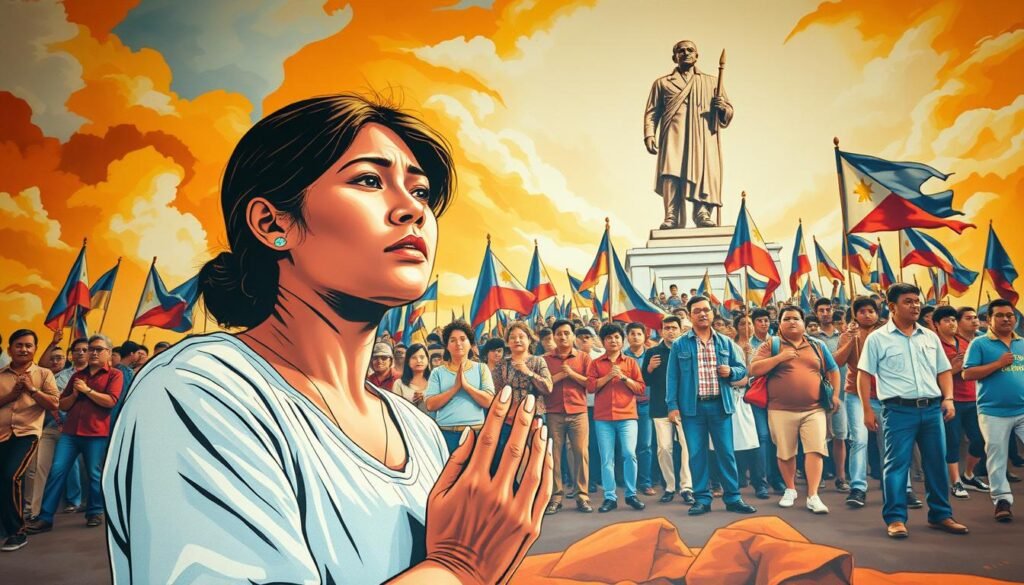
Ideological shifts during the American colonial era further enriched this dynamic. Leaders like Claro Mayo Recto emphasized the importance of self-determination, merging classical ideals with modern patriotism. As Recto noted,
“The Filipino people must define their own destiny, free from external influences.”
The revival of cultural traditions also played a crucial role. Movements that celebrated indigenous arts and languages strengthened the national spirit. This cultural awakening, combined with ideological reforms, created a unified vision for the nation-state.
Today, faith and ideology continue to serve as a guiding way for national unity. They inspire Filipinos to preserve their heritage while embracing progress. This balance between tradition and modernity remains a defining feature of the Filipino identity.
- Faith and ideology have shaped the Filipino spirit, fostering unity and progress.
- Religious traditions and cultural revival strengthened the national identity.
- Modern interpretations of the nation-state blend local and global influences.
- Patriotism emerged as a unifying force, driven by ideological and spiritual values.
Influential Figures in the Nationalist Struggle
The struggle for Filipino independence was fueled by the courage and vision of influential leaders who united the nation. These figures, both local and international, played pivotal roles in shaping the movement. Their contributions spanned different time periods and centuries, leaving a lasting impact on the country’s history.
Local Heroes and Revolutionary Leaders
Filipino history is rich with local heroes who dedicated their lives to the cause of independence. Leaders like Andres Bonifacio and Emilio Aguinaldo emerged during critical times, rallying the people against colonial rule. Bonifacio, the founder of the Katipunan, inspired a sense of unity and resistance. Aguinaldo, on the other hand, led the fight during the Philippine Revolution and later became the first president of the republic.
Another notable figure was Apolinario Mabini, known as the “Brains of the Revolution.” His intellectual contributions shaped the political framework of the movement. As Mabini once said,
“True independence is not just freedom from foreign rule but the ability to govern ourselves with dignity.”
International Inspirations and Debates
The Filipino struggle was also influenced by global movements and thinkers. Figures like Simón Bolívar and Giuseppe Mazzini inspired leaders with their visions of self-determination. These international debates enriched the local movement, providing new perspectives on governance and unity.
For example, the ideas of the French Revolution resonated deeply with Filipino intellectuals. They saw parallels between their fight for independence and the broader 19th-century nationalist movements. To learn more about these global influences, explore The Most Important People in 19th-Century.
These united efforts, both local and international, catalyzed the nationalist movement. They laid the foundation for a united Philippines, driven by a shared vision of sovereignty and cultural pride.
Nationalism and the Quest for Sovereignty
The quest for sovereignty has always been at the heart of political debates in the Philippines. The idea of self-governance has sparked intense discussions, shaping the nation’s identity and legal frameworks. From local movements to international influences, the pursuit of autonomy remains a defining theme in the country’s history.
Debates Over Statehood and Political Autonomy
One of the central debates revolves around the legitimacy of forming a sovereign state. Leaders and thinkers have long questioned whether political autonomy or full statehood is the best path forward. These discussions often intersect with law and governance, as legal frameworks play a crucial role in defining sovereignty.
For example, the Jones Law of 1916 promised eventual independence, encouraging Filipinos to strive for self-governance. This policy sparked debates about the balance between autonomy and external influence. As one historian noted,
“The struggle for sovereignty is not just about freedom but the ability to govern with dignity.”
Internationally, the rise of Inter-Governmental Organizations (IGOs) has transformed the nature of state sovereignty. The Philippines, like many nations, has had to navigate these global dynamics while preserving its local identity. The politics of recognition by IGOs has further complicated the path to full statehood.
| Key Policies | Impact on Sovereignty |
|---|---|
| Jones Law (1916) | Promised independence, encouraging self-governance |
| UN Charter (1945) | Provided a framework for transitioning to statehood |
| Local Governance Acts | Strengthened political autonomy at regional levels |
The idea of sovereignty has evolved alongside these legal and political changes. While some argue for complete independence, others advocate for a balance between local autonomy and global cooperation. These debates continue to shape the Philippines’ journey toward a unified and resilient identity.
For a deeper understanding of these historical debates, explore Sovereignty, Nationalism, and the Quest for. This resource provides valuable insights into the complexities of state formation and the role of law in shaping national identity.
The Interplay of Nationalism, Patriotism, and Culture
Cultural identity in the Philippines is deeply rooted in the interplay of shared values and historical narratives. This unique blend has shaped the Filipino spirit, fostering unity and pride. The fusion of patriotism and cultural practices has been a driving force in the nation’s journey toward self-determination.
Filipino society organizes itself around shared cultural and historical narratives. These stories, passed down through generations, create a sense of belonging and purpose. Artistic expressions, such as literature and visual arts, play a vital role in reinforcing these values. As one scholar noted,
“Art is not just a reflection of culture but a tool for shaping national identity.”
Public institutions also contribute to this cultural awakening. Schools, museums, and community centers serve as platforms for preserving and promoting local traditions. These organizations help unite diverse groups, fostering a collective sense of pride. For example, the National Museum of the Philippines showcases the country’s rich heritage, inspiring visitors to connect with their roots.
The multifaceted contributions of cultural elements cannot be overstated. Festivals like the Sinulog and Pahiyas celebrate local traditions while promoting unity. These events bring communities together, highlighting the importance of shared values. They are a part of the broader effort to strengthen national identity.
Movements and organizations also exemplify this interplay. Groups like the Katipunan and modern cultural advocates have played pivotal roles in shaping Filipino identity. Their efforts remind us that cultural pride and patriotism are inseparable. As one leader stated,
“Our culture is the foundation of our strength as a nation.”
| Cultural Element | Impact on Society |
|---|---|
| Artistic Expressions | Reinforce national values and identity |
| Public Institutions | Preserve and promote local traditions |
| Festivals | Celebrate unity and shared heritage |
In conclusion, the interplay of patriotism and culture has been a cornerstone of Filipino identity. Through shared narratives, artistic expressions, and public institutions, the nation continues to thrive. This dynamic relationship ensures that cultural pride remains a vital part of the Filipino spirit.
Economic Impacts of a Nationalist Movement
The rise of nationalist sentiment in the Philippines brought significant changes to its economic landscape. This shift was marked by a renewed focus on local industries and a rebalancing of trade practices. The language of policy evolved to reflect a growing emphasis on self-sufficiency and cultural pride.
Support for Local Industry and Policy Shifts
Nationalist movements influenced economic policies by prioritizing local industries. The government introduced measures to protect domestic businesses from foreign competition. This included tariffs and subsidies aimed at fostering growth in key sectors.
The sentiment of self-reliance resonated deeply with the public. Policies were designed to empower local entrepreneurs and reduce dependency on imports. For example, the promotion of agriculture and manufacturing became central to economic strategies.
As one economist noted,
“The shift toward nationalist policies was not just about economics but also about reclaiming cultural identity.”
Rebalancing Trade and Economic Strategy
Trade practices were redefined to align with nationalist goals. The Philippines sought to diversify its trade partners while reducing reliance on a single market. This approach aimed to create a more resilient and self-sufficient economy.
The impact on daily life was significant. Local markets flourished, and consumers began to prioritize domestically produced goods. This shift also fostered a sense of pride in supporting homegrown industries.
Key policy reforms included:
- Tariff adjustments to protect local industries.
- Incentives for small and medium-sized enterprises.
- Promotion of exports to new international markets.
These changes were not without challenges. Balancing protectionism with the need for global integration required careful planning. For a deeper understanding of these dynamics, explore Development and the Crisis of Global.
In conclusion, nationalist movements reshaped the Philippines’ economic landscape. By prioritizing local industries and rebalancing trade, the country took significant steps toward self-sufficiency. These efforts continue to influence its economic policies today.
Conflicts and Challenges within the Nationalist Landscape
The rise of nationalist movements in the Philippines has been marked by both internal and external challenges. These obstacles have tested the resilience of the movement and led to strategic redefinitions of its goals. Understanding these conflicts is essential to grasp the complexities of the nation’s journey toward unity.
Internal Divisions and the Complexities of Collective Identity
One of the most significant challenges has been internal divisions. The Philippines is a diverse nation with multiple ethnic groups, languages, and cultural traditions. This diversity, while a source of strength, has also created tensions within the nationalist movement. For example, the Moro struggle for autonomy in Mindanao highlights the difficulties of reconciling regional identities with a unified national identity.
Historical conflicts, such as the split between revolutionary leaders Andres Bonifacio and Emilio Aguinaldo, also underscore the complexities of collective mobilization. As one historian noted,
“Internal divisions often arise from differing visions of what a unified nation should look like.”
External Pressures and Border Disputes
External pressures have further complicated the nationalist landscape. Border disputes, such as those in the West Philippine Sea, have intensified debates over sovereignty and territorial integrity. These conflicts not only challenge the nation’s security but also its ability to maintain a cohesive national identity.
International interests, particularly from neighboring countries, have added another layer of complexity. The Philippines has had to navigate these pressures while striving to preserve its independence. For instance, the rise of China’s influence in the region has forced the country to reassess its foreign policy strategies.
Challenges as Catalysts for Change
Despite these obstacles, challenges have often spurred adjustments within the nationalist movement. Internal divisions have led to greater inclusivity, with efforts to address the concerns of marginalized groups. External pressures have strengthened the resolve to protect the nation’s sovereignty.
For example, the rise of grassroots movements advocating for indigenous rights has brought attention to the importance of cultural preservation. Similarly, border disputes have prompted the government to invest in defense and diplomacy, reinforcing the nation’s commitment to its territorial integrity.
- Internal divisions highlight the complexities of collective identity.
- Border disputes and external pressures test the nation’s sovereignty.
- Challenges have spurred strategic adjustments within the movement.
- Historical conflicts offer lessons for modern debates on national identity.
- Conflict has both undermined and strengthened nationalist unity.
In conclusion, the nationalist landscape in the Philippines has been shaped by both internal and external challenges. These conflicts have tested the movement’s resilience but also provided opportunities for growth and redefinition. By addressing these issues, the nation continues to strive toward a unified and inclusive national identity.
Contemporary Reflections on Historical Nationalism
The enduring impact of historical movements continues to shape the Philippines’ academic and policy landscapes today. From university research to governmental strategies, the legacy of these movements remains deeply embedded in modern society. This section explores how these influences manifest in current debates and practices.
Legacy in Modern Philippine Society
Historical movements have left a lasting imprint on the Philippines, particularly in the realm of education. Universities across the country often incorporate these narratives into their curricula, fostering a deeper understanding of the nation’s past. As one scholar noted,
“Understanding history is key to shaping a resilient and informed society.”
In the realm of policy, the echoes of historical movements are equally evident. Current strategies often draw inspiration from past struggles for autonomy and self-governance. For example, initiatives promoting local industries and cultural preservation reflect this enduring influence.
Contemporary views on these movements are shaped by ongoing political and cultural debates. While some advocate for a return to traditional values, others emphasize the need for modernization. This dynamic interplay highlights the complexity of the nation’s identity.
For a deeper exploration of these themes, consider the evolution of nationalism and its implications in various historical contexts. This resource provides valuable insights into how past movements continue to influence modern society.
- Historical movements shape modern education and research in universities.
- Current policies reflect the legacy of past struggles for autonomy.
- Contemporary debates highlight diverse views on cultural and political identity.
- Historical narratives inform societal and governmental strategies today.
Conclusion
Filipino identity has evolved through centuries of struggle and resilience, reflecting a rich tapestry of cultural and political influences. From pre-colonial traditions to modern governance, the nation’s journey has been shaped by a desire for self-determination and unity. Understanding these historical narratives is crucial for appreciating the value of identity in shaping modern political and cultural landscapes.
Contemporary debates highlight the ongoing challenges and contributions of movements that have defined the Philippines. These discussions often emphasize the importance of inclusivity, particularly in addressing the perspectives of the minority. By exploring these underrepresented voices, we gain a deeper understanding of the nation’s diverse heritage.
For further insights into the intersection of identity and global politics, explore the conclusion of “Nationalism and International Society”. This resource offers valuable perspectives on how historical movements continue to influence modern society.
FAQ
What is the significance of the nationalist movement in the Philippines?
The nationalist movement in the Philippines played a crucial role in shaping the country’s identity and quest for sovereignty. It united Filipinos against colonial rule and laid the foundation for modern political and cultural independence.
How did American rule influence Filipino nationalism?
American rule introduced political and cultural changes that both challenged and fueled Filipino nationalism. While it brought modernization and education, it also sparked resistance and a stronger desire for self-governance.
What role did education and media play in shaping Filipino identity?
Education and media were pivotal in promoting vernacular languages, literature, and cultural pride. They helped spread nationalist ideas and fostered a sense of unity among Filipinos during the colonial period.
Who were some key figures in the Filipino nationalist struggle?
Leaders like José Rizal, Andrés Bonifacio, and Emilio Aguinaldo were instrumental in the nationalist movement. Their writings, actions, and leadership inspired the fight for independence and shaped the nation’s history.
How did pre-colonial influences contribute to Filipino national identity?
Pre-colonial traditions, indigenous practices, and local governance systems provided a foundation for Filipino identity. These elements were later integrated into the nationalist movement as symbols of cultural pride and resistance.
What are the similarities between Filipino and European nationalisms?
Both Filipino and European nationalisms emphasized cultural identity, sovereignty, and resistance to foreign domination. However, the Filipino movement was uniquely shaped by its colonial experiences and local traditions.
How did economic policies shift during the nationalist movement?
The nationalist movement encouraged support for local industries and rebalancing trade policies. It aimed to reduce dependency on foreign powers and promote economic self-sufficiency.
What challenges did the nationalist movement face?
The movement faced internal divisions, external pressures, and debates over political autonomy. These challenges tested the unity and resilience of the Filipino people during their struggle for independence.
What is the legacy of historical nationalism in modern Philippine society?
Historical nationalism continues to influence modern Philippine society by fostering a sense of pride, unity, and cultural identity. It remains a cornerstone of the nation’s political and social development.
Source Links
- Filipino nationalism
- Milestones in the History of U.S. Foreign Relations
- July 4, 1946: The Philippines Gained Independence from the United States | The National WWII Museum | New Orleans
- Philippines – US Influence, Colonialism, Revolution | Britannica
- State and Sub-State Nationalism in Southeast Asia
- Filipino nationalism
- Political and Cultural Nationalism
- After Nationalism – Penn Press
- Nationalism Understanding: Citizens’ National Consciousness
- Nationalism | Definition, History, Examples, Principles, & Facts | Britannica
- Nationalism
- Digital Nationalism Understanding the Power of Digital Technology in the Rise of Nationalism, National Identity, and National Narratives
- Microsoft Word – 6226
- Nationalism and media- A historical overview and analysis
- Nationalizing Transnationalism? The Philippine State and the Filipino Diaspora
- Nationalism and Religion in Comparative Perspective: A New Typology of National-Religious Configurations | Nationalities Papers | Cambridge Core
- Comparing Levels of Religious Nationalism Around the World
- Nationalism – European Identity, Unity, Patriotism | Britannica
- Eric Storm on the rise and evolution of nationalism
- Religious nationalism
- Nationalism as an ideology
- Milestones in the History of U.S. Foreign Relations
- The Fate of Nationalism in the New States: Southeast Asia in Comparative Historical Perspective | Comparative Studies in Society and History | Cambridge Core
- Nationalism, Sovereignty, and Supranational Organizations
- The Quest for Statehood: Korean Immigrant Nationalism and U.S. Sovereignty, 1905–1945. By Richard S. Kim. Oxford: Oxford University Press, 2011. xii, 223 pp. $99.00 (cloth); $21.95 (paper). | The Journal of Asian Studies | Cambridge Core
- Nationalism, Patriotism, and Education for Patriotic Citizens in Mainland China
- Nationalism and National Identity in North America | Nationalities Papers | Cambridge Core
- Economic nationalism
- Conclusion and Outlook: Explaining Economic Nationalism (Chapter 9) – The Nationalist Dilemma
- A New Era of Conflict and Violence | United Nations
- Introduction (Chapter 1) – Democracy and Nationalism in Southeast Asia
- Minding the Nation Anew: Reflections on Recent Studies of Nationalism
- National History and New Nationalism in the Twenty-First Century | A G
- Revisiting key debates in the study of nationalism – Humanities and Social Sciences Communications
- Nationalism and Globalisation: Conflicting or Complementary?

